Bedtime Story
Why do we snooze? UW researchers are pursuing an unconventional theory — that our brains downsize while we sleep, getting us ready to face another day.
We all need sleep. Without enough of it, we’re irritable, can’t focus, and are more likely to catch the latest bug going around the office. Entire industries — high-tech mattresses and pharmaceuticals, for starters — are devoted to both our pursuit of sleep and our lack of it. Starbucks, anyone?
Sleep can be elusive in today’s world, though it’s just as crucial for our survival as it has always been. But why, exactly, do we need it? It’s not because we have nothing better to do. Every species sleeps, though, including lowly fruit flies, regardless of the danger that doing so poses by making them vulnerable to would-be predators.
“Nobody has a question about what the heart does, or why do we eat, or why do we have sex, or why do we have emotion — all of those things are perfectly obvious. But why do we sleep? A third of our time we become unconscious to the world,” says Giulio Tononi, professor of psychiatry and part of the newly established University of Wisconsin Center for Sleep Medicine and Sleep Research.
That fact alone — the hours that we devote to sleep — tells Tononi and other UW researchers working to unravel the mysteries of sleep that it serves a core function, beyond the other benefits that it appears to provide to our health. But so far, scientists have not been able to determine precisely what is happening in our bodies, and particularly in our brains, while we slumber. There’s more to their search than the reward of discovery: finding out could someday lead to relief for the tens of millions of people who suffer from sleep disorders, as well as provide tools for diagnosing mental illnesses such as depression and schizophrenia.
Tononi and the UW research group are not the only scientists working to find the answer. But what makes them unique are their multiple investigative approaches and their working theory about the function of sleep, which just happens to be quite unlike what many of their fellow sleep researchers are trying to prove.
Sleep Lab of the Future
In ancient Greece, Hippocrates, considered the founder of medicine, observed that sleeplessness was connected with “sorrow and pains.” But the modern era of sleep research did not begin until the twentieth century, with the invention of electroencephalography (EEG), which uses electrodes attached to the head to record brain activity. In 1953, scientists using EEG achieved a landmark in sleep research by discovering rapid eye movement, the stage of sleep during which we dream.
Today the UW can claim the world’s largest high-density EEG facility, called Wisconsin Sleep, where researchers are collaborating across disciplines in an untraditional way to get results. Doctors use what looks like a high-tech hairnet, a skullcap made of 256 electrodes, rather than applying two or three electrodes individually to patients. The result is a functional map of the brain that allows analysis of each brain wave in detail, serving as a major tool for research as well as helping patients with serious sleep problems.
Among other studies, the UW researchers are using EEG to measure how the patterns of brain activity change in people with depression or schizophrenia, or those who take antipsychotic drugs. The technology provides a window into a patient’s brain; Tononi compares it to a mechanic listening to a car engine while it idles to figure out what’s wrong. “When we sleep we are all alike,” he says. “That’s why sleep is a good way to look at the brain by itself, without asking the brain to do anything.”
UW sleep researchers peek inside sleeping brains at the Wisconsin Sleep clinic in University Research Park on Madison’s west side, where rooms resemble those at a comfortable hotel more than a medical setting, complete with flat screen satellite TVs. Most of those rooms are dedicated to the clinic’s main focus: treating patients who range from children to the elderly. The clinic’s patients and research subjects spend the night under the watchful eye of an infrared video recorder, which is hooked up to a control room of sorts down the hall where clinical staff can monitor sleep patterns and brain waves. Graduate students come from all over the world to train here, says Ruth Benca, director of the UW Center for Sleep Medicine and Sleep Research.
Many of the patients suffer from sleep apnea or breathing disorders, but the clinic also sees people with circadian-rhythm problems — those who can’t sleep at night — and patients with cases of insomnia that are too complex for family doctors to evaluate.
“Understanding what’s functionally important about sleep will help us devise better treatments to take care of these disorders,” Benca says.
Choosing a specific treatment depends on each patient, but ultimately, because of the unanswered questions about the function of sleep, the clinic’s work is not an exact science. What doctors can do is try to help patients fall asleep faster and stay asleep longer, in hopes they will feel more refreshed in the morning.
But if researchers could uncover sleep’s true function, Benca’s team at Wisconsin Sleep could then determine how well that job is being performed for an individual patient during sleep.
In other words, the kind of sleep we get may matter more than how much sleep we get.
Sleep Pioneers
In 2005, the National Institutes of Health (NIH) gave Tononi a Pioneer Award, a grant program designed, according to NIH, to support scientists of “exceptional creativity who propose pioneering — and possibly transforming — approaches to major challenges in biomedical and behavioral research.” The five-year, $2.5 million award serves as recognition that the practical potential of Tononi’s work at the UW is major. The program rewards researchers whose work is “substantially different” from that being pursued in other laboratories — and Tononi is just fine with that, believing that his research group is on the right track.
Some researchers, including those at the UW, have shown that people improve in particular tasks by 10 to 15 percent after a night of sleep. Based on those findings, the hypothesis that many sleep scientists are hotly pursuing holds that during sleep the synapses — the connections between nerve cells in the brain — get stronger as the brain replays what it sees and learns during the day and consolidates all of those memories.
But Tononi and other UW researchers think that cannot be the whole story of sleep.
The traces of everyday experience in our brains — what we do, what we see on our way to work, and all of the brief conversations we have — are huge. Synapses are the bank for those memories, and those connections get stronger the more we “learn,” getting bigger and taking up more space and energy. Literally, your head is heavy, Tononi says, and the price we pay for a brain that continues to learn is that those connections are weakened.
“In the morning, you’ve got a V6 [engine] that’s idling. In the evening, you’ve got a V8 that’s idling,” Tononi says.
The problem is that this pattern is not sustainable. That’s why Tononi and other UW researchers believe the synapses actually “downscale” and the connections between nerve cells weaken while we sleep. When we wake up, the brain is consuming less energy, occupying less space, and ready to learn again.
EEGs show that 80 percent of sleep is characterized by strong, slow waves, like a stadium full of people shouting in unison, while weaker waves are like the buzz in a crowded restaurant. Tononi thinks that those waves, which get smaller throughout the night, reflect how strong connections in the brain are, and that they also play an important role in weakening those connections during sleep. With high-density EEG, researchers can see where slow waves are born, how fast they travel, and to which regions of the brain.
Tononi and his colleague Chiara Cirelli, an associate psychiatry professor, proved their basic premise when they measured the strength of brain connections in rats and found that after the rats had been awake for a few hours, the connections were 50 percent stronger.
“This is direct evidence for the hypothesis,” Tononi says. “So we are pleased because the likelihood that it was wrong [was] high.
It seems the brain is the organ that needs sleep the most, Cirelli says. Otherwise, resting on the couch while watching TV or reading would be enough to restore us. The importance of slow waves in the brain during sleep could also explain why some people seem to do just fine on four hours of sleep, while the rest of us don’t function well with fewer than eight hours.
If the job of sleep does, in fact, rely on slow waves, the number that a person’s brain produces during sleep would be crucial and could explain that huge variability among individuals, Cirelli says.
“People always ask … ‘How many hours should I sleep?’ I don’t know. Really — I don’t know. The answer is you should sleep as many hours as you feel you need,” Cirelli says. “Hopefully in the future … you could measure how much synapses have been downscaled, if that’s really crucial … but we are not there yet.”
Finding the Right Genes
Cirelli is at the forefront of one of the fastest growing areas in sleep research. She is trying to identify the genes that are responsible for sleeping and waking, and, in particular, which gene carries the signal that shuts down connections in the brain during sleep. She and Tononi both got their start at the University of Pisa in Italy, home to Giuseppe Moruzzi, a major player in sleep research who also used EEG to study the brain during sleeping and waking.
“When you go into sleep [research], it is such a fascinating world, and because there are still so many things to study, it’s easy to get trapped,” Cirelli says with a laugh.
A collection of networks forms systems for sleep and waking, rather than one specific center in the brain. But scientists still don’t know why the pressure to go to sleep increases if a person stays awake for too long, something they’ve seen in studies of animals and humans.
“Why is it that the brain cells need to sleep? That’s a different story, and that’s really what we are trying to understand,” Cirelli says.
The UW team is searching for specific genes that are the most important in carrying that sleep signal, which they believe gets activated when connections in the brain become too big and strong. “There is something that puts you to sleep,” Cirelli says.
She’s been researching sleep at the molecular level for fifteen years, and there’s no shortage of work to do — hundreds of genes change between sleep and waking. “People thought that at the molecular level, sleep was silence,” she says. “Instead, that’s not the case; it’s just that there are different kinds of genes that are active during sleep.”
In an effort to identify those genes, Cirelli is screening thousands of lines of fruit flies. The flies are a good fit for this work because their nervous systems are complex enough to apply to humans and other mammals — they even stay awake when they have caffeine — yet they also allow for rapid genetic screening. Although the UW researchers haven’t found a mutation that creates a fly that never sleeps, they have identified a gene that causes flies to sleep one-third the amount of normal flies, a process that took five years. The goal is to find other specific genes involved in sleep, including those that tell synapses to take a break and weaken connections between nerve cells.
“It’s almost impossible to get funding for doing these kinds of studies because they are considered fishing expeditions, which is a very, very negative term in research, meaning that you have no clue,” Cirelli says. But since other sleep- research efforts in the 1990s were not explaining sleep function, she says, the UW researchers “had to be completely unbiased and just try to check and look at all the genes.”
What Lies Ahead
The promise of the research surrounding sleep is tantalizing, even if the clinical applications are not remotely close to becoming reality yet.
Tononi and his colleagues have stimulated slow waves like those found during the deepest stages of sleep by placing a specialized electromagnet on the scalp of sleeping patients, generating short, magnetic pulses that activate electrical impulses in the brain. These slow waves on demand could someday lead to treatments for insomnia and a magnetically stimulated “power nap,” providing the benefit of a full night’s sleep in just a few hours.
And with studies of brain activity during sleep using the high-density EEG, researchers could also develop diagnostic tools for identifying mental illnesses and assist doctors who are working with stroke patients to determine how successfully rehabilitation
sessions are restoring language.
While it may sound strange to someone who hasn’t devoted hours and hours in a laboratory, tirelessly repeating the same experiment over and over again, the UW’s sleep researchers are willing to spend significant time essentially trying to disprove their own theories.
“You always have to remember that we are all wrong — [which is] based on the fact that now we know too little to be right,” Cirelli says.
Sleep is a comprehensive field, cutting across every branch of medicine. Residents from UW programs in psychiatry, neurology, internal medicine, and pediatrics can elect to do rotations in the sleep-research center. UW researchers have elected to collaborate extensively among the disciplines and employ a broad range of methods, including the study of both animals and humans using electrophysiology,
biochemistry, and computer modeling.
“I think there is a cooperative spirit here. People like to work together,” Tononi says. “It is not a cutthroat environment where the next guy is your worst enemy.”
And what motivates them is the scope of problems that could be addressed by discovering the whole story of why we sleep.
“People have learned by previous disasters, so to speak, to stay away from this question because you’re almost certainly going to be wrong,” Tononi says. “Despite everything, I think that’s what’s worth doing. Give it shot. Maybe you’re lucky. Maybe not.”
Jenny Price ’96 is a writer for On Wisconsin. She was preparing for a sleep-deprivation experiment as this issue of the magazine went to press, thanks to the arrival of her second child.
Published in the Spring 2009 issue
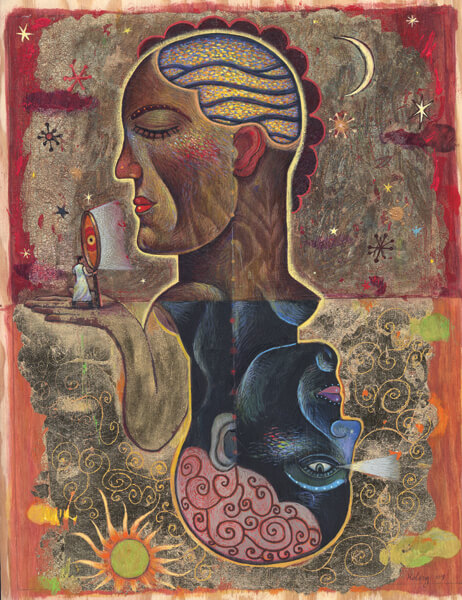
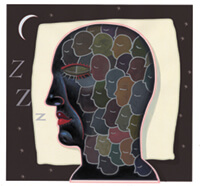
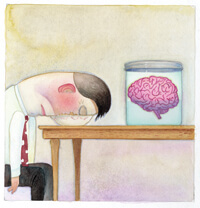
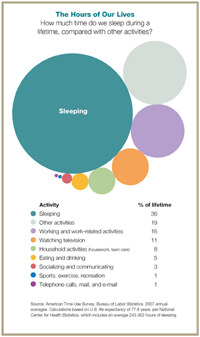
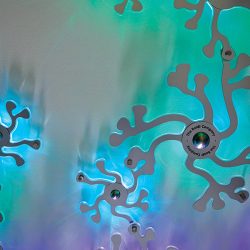

Comments
No comments posted yet.